Ask any Guyanese, at home or abroad, to name the first five things Guyanese that readily come to mind, and they often reply, Kaieteur Falls, Stabroek Market, St George’s, Parliament Buildings, Town Hall, and sometimes, Jonestown. Can you imagine they always forget our Sea Wall, which actually saves the capital city of Georgetown from being a Venice, and our coastline languishing as another lost continent of Atlantis.
Large portions of the Guyana coastline stretching 425 kilometres from Venezuela to Suriname lie below high tide level, and defence from the threatening Atlantic has been a battle ever since the planters began to lay out estates along parts of the coast at the very end of the eighteenth century. And the perennial challenges continue today.

The depredations of the sea claimed plantations Kierfield and Sandy Point near what is now Kitty in 1792, and there has been periodic flooding at various points along the East Coast Demerara for two centuries. In February1855, for example, the spring tide rose to a height unknown for the previous fifty years, inundating the ward of Kingston and flooding as far as Plantation Ogle. The flood swamped the railway embankment, and salted the head of the Lamaha Canal. Camp House which had once been the residence of the early governors had to be dismantled. The building of the Georgetown Sea Wall commenced that year, and the plaque off the Round House indicates that the first section from Fort Groyne to the Round House was completed by 1860.
Deadly duels by sword and pistol plus horse racing were staged on the beach between Camp Street and Kitty in the early nineteenth century, although the beach was later washed away.
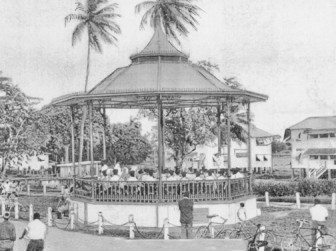
The Governor’s Pond at King’s Ground, was dug to provide dirt for a continued embankment to the Bandstand area and by 1872 the Sea Wall had reached Kitty. The Bandstand was built in 1903 as a memorial to Queen Victoria, with the small hut Koh-i-noor opposite, at the same time. This hut has now been demolished because of vagrants.
By April 1882 the Sea Wall had reached as far as Unity, East Coast, while some other coastal areas were protected by mangroves and courida, earth dams and jetties. Today mangrove replanting assisted by Anette Arjoon-Martins and the Mangrove Action Committee is a top priority. Heavy boulders, concrete walls and rip-rap defences help in our constant battle to defend our foreshore.
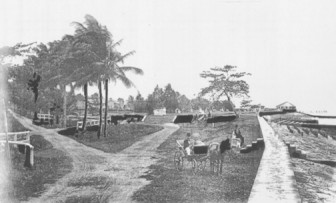
The romance of the Sea Wall has been truly reflective of our maturation in Georgetown these last seven decades. During the war years of the forties, the Sea Wall was our haven for small boy escapades – skulking hokey from public school, skinny dipping, catching crabs, four-eyes fish, and birds. A big ‘chapta’ thrill was standing seaward at the end of the slippery jetties with the raging Atlantic attempting to wash you overboard.
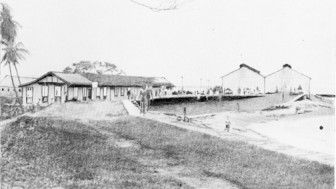
By the teenage years, the sand flat off Camp Street was our ‘Lords,’ where daily cricket duels weaned many national cricket stars, including Charlie Stayers, Pat Legall and Colin Croft, etc. Thousands gathered at Easter to fly kites on or around the Sea Wall, relishing delightful family picnics, body building and fashion contests.
The Bandstand was a major attraction, especially after Bandmaster Ken De Abreu broadened the repertoire of the local Police Band which emerged from the Militia Band in 1957, and began to play popular folk, calypso, reggae, and jazz. The public Saturday afternoon concerts were a delightful treat for the citizenry. Morning exercises and evening strolls, enjoying our fresh sea breeze was a Limacol delight for young and old.
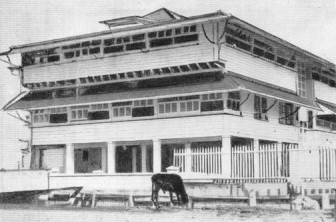
Daily, several heads of the government departments and commercial houses, plus know-it-all citizens would meet at the benches off the Bandstand to debate how the country could be successfully governed. I referred to them then as ‘the Poke-a-hole’ in the Sea Wall Fresh Air Party, now extinct and replaced today by erudite email letters to newspaper editors. Alya remember the Keyholt wreck outside the Demerara Harbour?
By adulthood as hormones raged, the Sea Wall was a romantic trysting place – a public bedroom – a private parking promenade for lovers. During the banlon years of the seventies, choke and rob reared its ugly head in our once peaceful society, and the Sea Wall become less popular as a local oasis. Today’s Sea Wall Sunday lime opposite the Subryanville residences, east of the former D’Aguiar and later Russian Embassy Turn is the popular attraction.
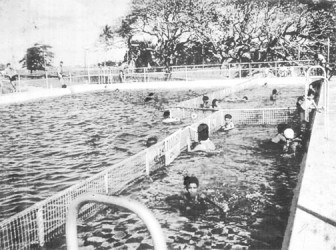
The Kitty Sea Wall hut was the venue of the annual May fair on the last Saturday of May yesteryear. Today, that site is La Chalet. Must mention here the Adamson Bend scandal, July 12, 1945 when a sensational murder took place at the bend, opposite the former entrance of St Stanislaus Ground to the Sea Wall. Forty-eight year-old James Adamson, Class I Customs Clerk, a patient at the Geogetown Hospital had a recuperating tryst with a nurse at this bend, previously called ‘Dixie,’ when they were attacked by a cutlass wielding vagrant. Adamson died shortly after. Hilton Dhoney, a labourer, was charged but acquitted in a sensational trial that launched a young J O F Haynes, to an illustrious legal career.
Refer Hammie Green’s Anthology of Georgetown for fuller details of this nylon.
In the early fifties the Carib Hotel was our mecca for dancing under their starry roof, while the Bel Air Hotel, a half mile westward was a popular oasis where the Penumbrians, a civil servants club held their debut dance in 1954.
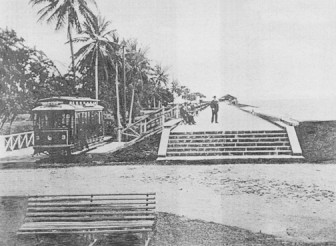
Mayor Lionel Luckhoo built the Luckhoo Pool in the early sixties at the Water Street end of the Sea Wall where thousands enjoyed aquatic sports, etc. A few years later due to subsidance of the foundation, the pool was abandoned. Pegasus built at the site of Governor’s Pond opened in 1969. The Umana Yana was built by the Wai-Wai tribe for the Non-Aligned Foreign Ministers Conference of 1973. Bookers Staff Sports Club came on stream in the early fifties, after Bookers Universal was rebuilt following the great fire of 1945, and opened in 1951.
Carifesta Avenue was built on Kelly’s Dam, which was our secondary sea defence for north Georgetown from Camp Street to Vlissengen Road.
Many of the Guyanese diaspora reading this will reminisce about their wonderful moments basking on the Sea Wall. Dr Ian McDonald recalls attending the 100the anniversary dance of the Georgetown Cricket Club at the Carib Hotel in 1958, and the champion BG Brandon Trophy Tennis team training under McDonald Bailey at 5am on the Sea Wall in 1957.
A recent film documentary on the Sea Wall was presented at the Cannes Film Festival May 2011. The Saga and Romance of the Sea Wall lives on.
For more Nostalgias refer to Godfrey’s Nostal-gias: Golden Memories of Guyana 1940 to 1980 available at Austin’s Bookstore, or check out Godfrey Chin at Google or Yahoo.




